Born
in Hawthorn on 23 June 1907, John Alfred La Gerche was one of three
children (and only son) of Alfred Romeo La Gerche (1873-1948) and the
former Ellen May Foster (1881-1974). He was also grandson and
namesake of John La Gerche (1845-1914), a leading forester who served
for many years as Crown Lands Bailiff to the Ballarat & Creswick
State Forest. In pursuing a career in architecture, the younger
John La Gerche followed in the footsteps of his own father, who was
appointed Chief Architect of the State Electricity Commission (SEC)
when the body was established in 1919, and would hold the position
until retirement in 1937. His son was already following suite by
1928, when he received a commendation for his entry in a design
competition for the new Sydney headquarters of the Royal Society of
NSW.
In 1930, John La Gerche enrolled at the University of Melbourne Architectural Atelier, where his classmates included such future luminaries as Best Overend, Rhys Hopkins, Garnet Alsop and Balcombe Griffiths. A keen and active member of the VASS, La Gerche served as the society's Honorary Secretary and penned an article in its journal on the then feather-ruffling topic of women in architecture. During this time, he also served as a cadet with the Melbourne University Rifles and pursued professional experience in architectural offices. Hardly surprisingly, his first job was in the Architectural Branch of the SEC, where he worked as a Pupil Architect from 1930 to 1934. After completing his Diploma of Architectural Design, he spent two years as a draftsman with Walter & Richard Butler, followed by five years as Chief Draftsman in the office of Frederick Morsby. He appears to have been principal involved in residential work, as it was later reported that "many of his pre-war houses look as modern as anything being built today". During this busy time, La Gerche was elected as an associate to the RVIA. His personal life was no less active: in March 1938, he married Nancy (Nan) Edith Robinson (1912-1992) from Ivanhoe, where La Gerche’s own family had resided for many years.
In February 1942, La Gerche enlisted with the RAAF and, two months later, was transferred to the Administrative & Special Duties Branch, where his colleagues included fellow architect Roy Grounds. Stationed for a time in Queensland, La Gerche was assisted by a young Brisbane architect, six years his junior, by the name of Guilford Bell. In June 1963, La Gerche was promoted to the rank of Flight Lieutenant. At the time of his discharge in July 1946, by which time he had been further elevated to Squadron Leader, he was attached to the Allied Forces Headquarters as a Director of Works & Building.
Resuming civilian life, La Gerche took up the position of Chief Architect to Ansett Transport Industries, which may have come about via his wartime connection with Guilford Bell, who had himself worked for Ansett in the late 1930s. In this capacity, La Gerche was responsible ‘for the design, planning and interior decoration of the company’s chain of hotels and booking offices throughout Australia’. In 1948, he became involved in an ambitious scheme, initiated by a subsidiary company called Barrier Reef Hotels Pty Ltd, to develop luxury resorts in northern Queensland. The company dispatched a party that included La Gerche, Bell and engineer John Campbell (another ex-RAAF serviceman) to complete a survey of islands from Hayman to Goldsmith and back again. Hayman Island was selected as the best site for what was to be Australia’s first purpose-built tourist resort, and a design was duly prepared. Although it has been suggested that the project was undertaken solely by Bell with no input by Le Gerche, contemporary newspapers credit Le Gerche with the overall design, while noting that Bell was responsible for the interior design and the supervision of construction.
In 1950, around the time that the Hayman Island hotel was completed, La Gerche resigned from his position with Ansett and, the following year, commenced private practice in Melbourne. During its early years, his office operated from Leonard House at 44-46 Elizabeth Street, a pre-war building by Walter Burley Griffin that featured a notably early application of curtain walled technology. Coincidentally or not, La Gerche went on to design some of the first true curtain-walled office buildings in the city, beginning with the twelve-storey Gilbert Court at 100 Collins Street, designed in 1953 and completed in 1955. The slick glass-walled building attracted considerable attention, with La Gerche himself transferring his own office there upon completion. The groundbreaking project was followed by three other glazed towers in Collins Street: Royston House at No 51 (1954), the Coates Building at No 18-22 (1957), and an unrealised scheme at the corner of Elizabeth Street (1956).
Little is yet known of La Gerche’s later career as he approached retirement age during the 1960s. According to a biographical profile from the early 1950s, his hobbies included gardening (a throwback to the horticultural interests of his late grandfather) and painting. Remaining registered as an architect until 1985, La Gerche died seven years later, on 20 February 1992.
In 1930, John La Gerche enrolled at the University of Melbourne Architectural Atelier, where his classmates included such future luminaries as Best Overend, Rhys Hopkins, Garnet Alsop and Balcombe Griffiths. A keen and active member of the VASS, La Gerche served as the society's Honorary Secretary and penned an article in its journal on the then feather-ruffling topic of women in architecture. During this time, he also served as a cadet with the Melbourne University Rifles and pursued professional experience in architectural offices. Hardly surprisingly, his first job was in the Architectural Branch of the SEC, where he worked as a Pupil Architect from 1930 to 1934. After completing his Diploma of Architectural Design, he spent two years as a draftsman with Walter & Richard Butler, followed by five years as Chief Draftsman in the office of Frederick Morsby. He appears to have been principal involved in residential work, as it was later reported that "many of his pre-war houses look as modern as anything being built today". During this busy time, La Gerche was elected as an associate to the RVIA. His personal life was no less active: in March 1938, he married Nancy (Nan) Edith Robinson (1912-1992) from Ivanhoe, where La Gerche’s own family had resided for many years.
In February 1942, La Gerche enlisted with the RAAF and, two months later, was transferred to the Administrative & Special Duties Branch, where his colleagues included fellow architect Roy Grounds. Stationed for a time in Queensland, La Gerche was assisted by a young Brisbane architect, six years his junior, by the name of Guilford Bell. In June 1963, La Gerche was promoted to the rank of Flight Lieutenant. At the time of his discharge in July 1946, by which time he had been further elevated to Squadron Leader, he was attached to the Allied Forces Headquarters as a Director of Works & Building.
Resuming civilian life, La Gerche took up the position of Chief Architect to Ansett Transport Industries, which may have come about via his wartime connection with Guilford Bell, who had himself worked for Ansett in the late 1930s. In this capacity, La Gerche was responsible ‘for the design, planning and interior decoration of the company’s chain of hotels and booking offices throughout Australia’. In 1948, he became involved in an ambitious scheme, initiated by a subsidiary company called Barrier Reef Hotels Pty Ltd, to develop luxury resorts in northern Queensland. The company dispatched a party that included La Gerche, Bell and engineer John Campbell (another ex-RAAF serviceman) to complete a survey of islands from Hayman to Goldsmith and back again. Hayman Island was selected as the best site for what was to be Australia’s first purpose-built tourist resort, and a design was duly prepared. Although it has been suggested that the project was undertaken solely by Bell with no input by Le Gerche, contemporary newspapers credit Le Gerche with the overall design, while noting that Bell was responsible for the interior design and the supervision of construction.
In 1950, around the time that the Hayman Island hotel was completed, La Gerche resigned from his position with Ansett and, the following year, commenced private practice in Melbourne. During its early years, his office operated from Leonard House at 44-46 Elizabeth Street, a pre-war building by Walter Burley Griffin that featured a notably early application of curtain walled technology. Coincidentally or not, La Gerche went on to design some of the first true curtain-walled office buildings in the city, beginning with the twelve-storey Gilbert Court at 100 Collins Street, designed in 1953 and completed in 1955. The slick glass-walled building attracted considerable attention, with La Gerche himself transferring his own office there upon completion. The groundbreaking project was followed by three other glazed towers in Collins Street: Royston House at No 51 (1954), the Coates Building at No 18-22 (1957), and an unrealised scheme at the corner of Elizabeth Street (1956).
Little is yet known of La Gerche’s later career as he approached retirement age during the 1960s. According to a biographical profile from the early 1950s, his hobbies included gardening (a throwback to the horticultural interests of his late grandfather) and painting. Remaining registered as an architect until 1985, La Gerche died seven years later, on 20 February 1992.
Select List of Projects
Chief Architect, Ansett Transport Industries
| 1947 1948 1949 | Alterations and additions to residence, Frankston (with Guilford Bell) ANA air terminal Phillip Street, Sydney (with Guilford Bell) Royal Hayman Hotel, Hayman Island, Queensland (with Guilford Bell) |
John A La Gerche
| 1941 1953 1953 1954 1955 1956 1957 1959 | Residence for self, 362 Lower Heidelberg Road, Heidelberg Office building (Gilbert Court), 100 Collins Street, Melbourne Residence, Warrandyte Residence, Balwyn North Alterations and additions to hotel, Port Melbourne Office building (Royston House), 51 Collins Street, Melbourne Residence, Heidelberg Alterations and additions to Old England Hotel, Heidelberg Alterations and additions to Junction Hotel, Melbourne Alterations and additions to showrooms, Glenferrie Road, Malvern Office tenancy fitout for Pan Am Airways, 85 Collins Street, Melbourne Office building for Lex Davison, corner Collins and Elizabeth Street [not built] White’s Meadow Drive-in Shopping Centre, Templestowe Office building (Coates Building), 18-22 Collins Street, Melbourne |
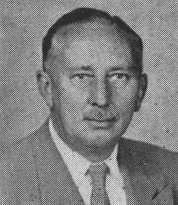 | |
| John A La Gerche, architect, in the mid-1950s |
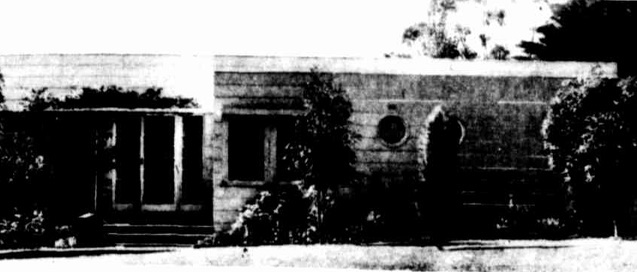 | |
| John La Gerche's own house, Heidelberg (1941) |
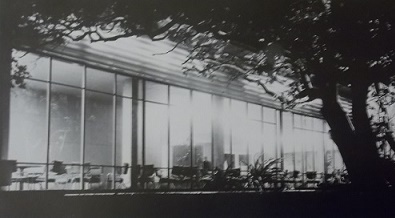 | |
| Royal Hayman Island Hotel, Queensland (1948-50) |
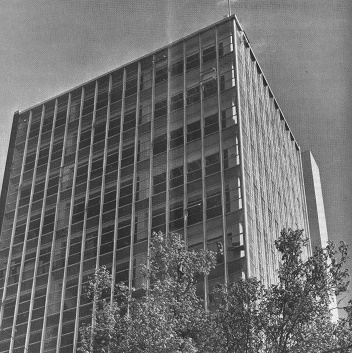 | |
| Gilbert Court, 100 Collins Street, Melbourne (1953) |
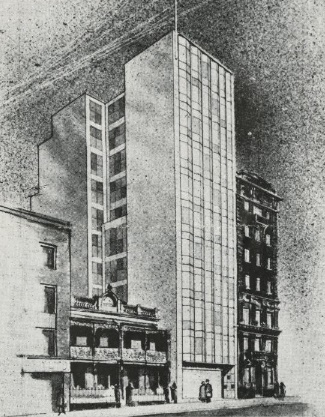 | |
| Royston House, 51 Collins Street, Melbourne (1954) |
